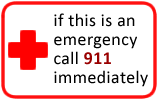|
Definition
General Information: Snakebites most commonly occur on the hands, arms, ankles, or legs when an individual attempts to play with or capture a snake. Types of Snakebites
Poisonous Snakes
Poisonous snakebites result in 12 to 15 deaths per year in the United States. (1 to 2% of the total poisonous bites). There are two main families of poisonous snakes in the U.S. and Canada: Pit Vipers and Coral Snakes. Pit Vipers: The different members of the pit viper group include rattlesnakes, copperheads, and cottonmouths (water moccasins). The venom from pit vipers first causes localized pain and swelling and then later causes generalized symptoms of weakness, nausea, and sweating. Coral Snakes: The venom from a coral snake is toxic to the nervous system. A bite can cause severe weakness or paralysis with minimal pain or swelling at the bite mark. The patterning and coloration consists of bands of dark-red, yellow, and black. The red bands have yellow bands on each side. There are various rhymes that have been made up to remember this pattern. One example is "Red on Yellow, kill a fellow. Red on black, venom lack." Poisonous Snakebites - Symptoms
Poisonous snakes have fangs that leave fang marks (1-2 tiny puncture wounds) on the skin at the snakebite site. No symptoms. In about 20% of poisonous snakebites, no venom is injected (dry bites). Local symptoms. If the venom was injected (envenomation), the fang marks will begin to burn and hurt within 5 minutes and swell within 30 minutes. (Exception: the coral snake can cause severe weakness or paralysis with minimal pain or swelling at the bite mark.) Systemic (generalized) symptoms. General body symptoms (e.g., nausea, sweating, weakness) may take several hours to develop. The severity of symptoms depends on the quantity of venom injected, degree of venom toxicity, location of the bite, snake species and size, and the victim's age and size. Non-Poisonous Snakebites
Most non-poisonous bites occur during attempted capture or are from pet snakes. A non-poisonous snakebite may appear as a semi-circular pattern of small teeth marks. Often, the small teeth of the non-poisonous snake leave a scrape that doesn't even puncture the skin. Unknown (Unidentified) Snakes
Sometimes the snake disappears shortly after the bite. In other cases, the snake has been killed but is hard to identify. Most bites are from harmless snakes. Generally, you can assume that it is a non-poisonous snakebite if there is no local pain, no local swelling, and no fang marks (puncture wounds). |
First Aid:FIRST AID Advice for Poisonous Snake Bite: The following first aid measures are recommended for ALL poisonous snake bites:
Move away from the snake. Victim should remain calm and minimize activity (to reduce absorption and circulation of the venom). Promptly transport victim to a medical facility. Victim should not eat or drink anything. |



